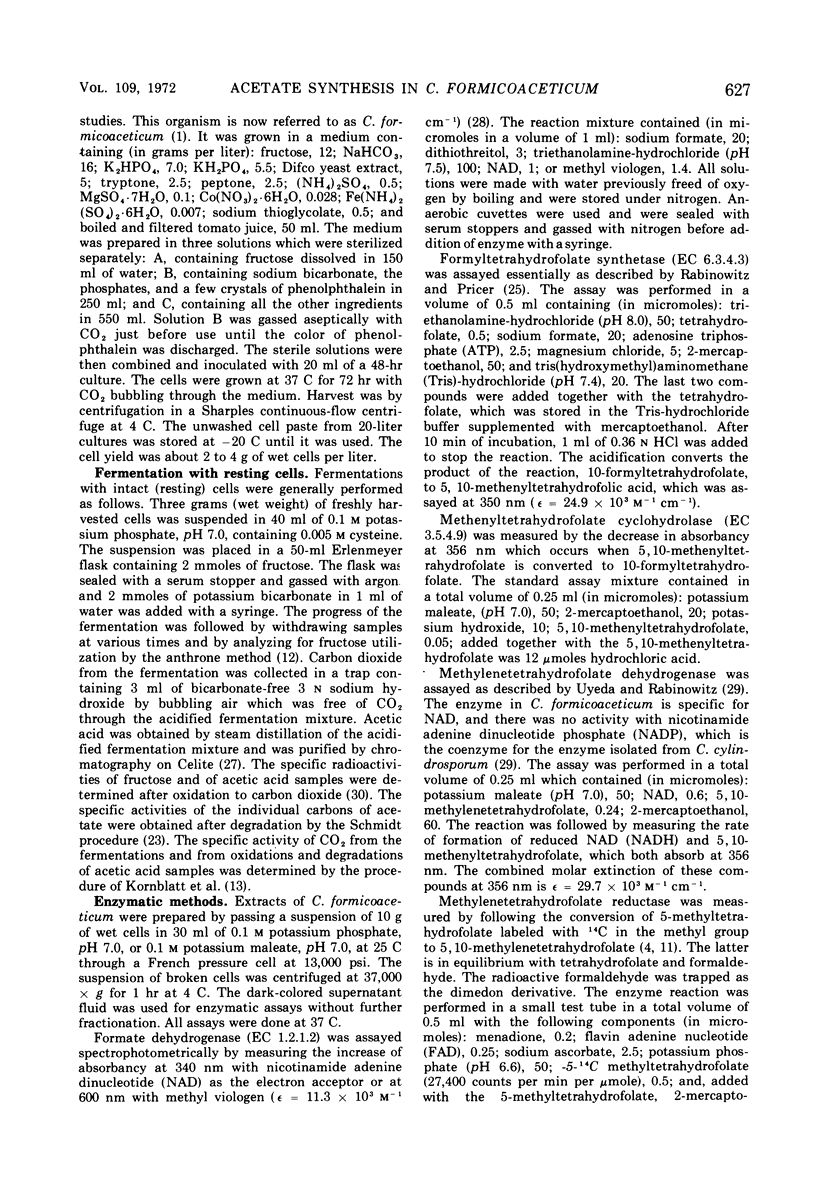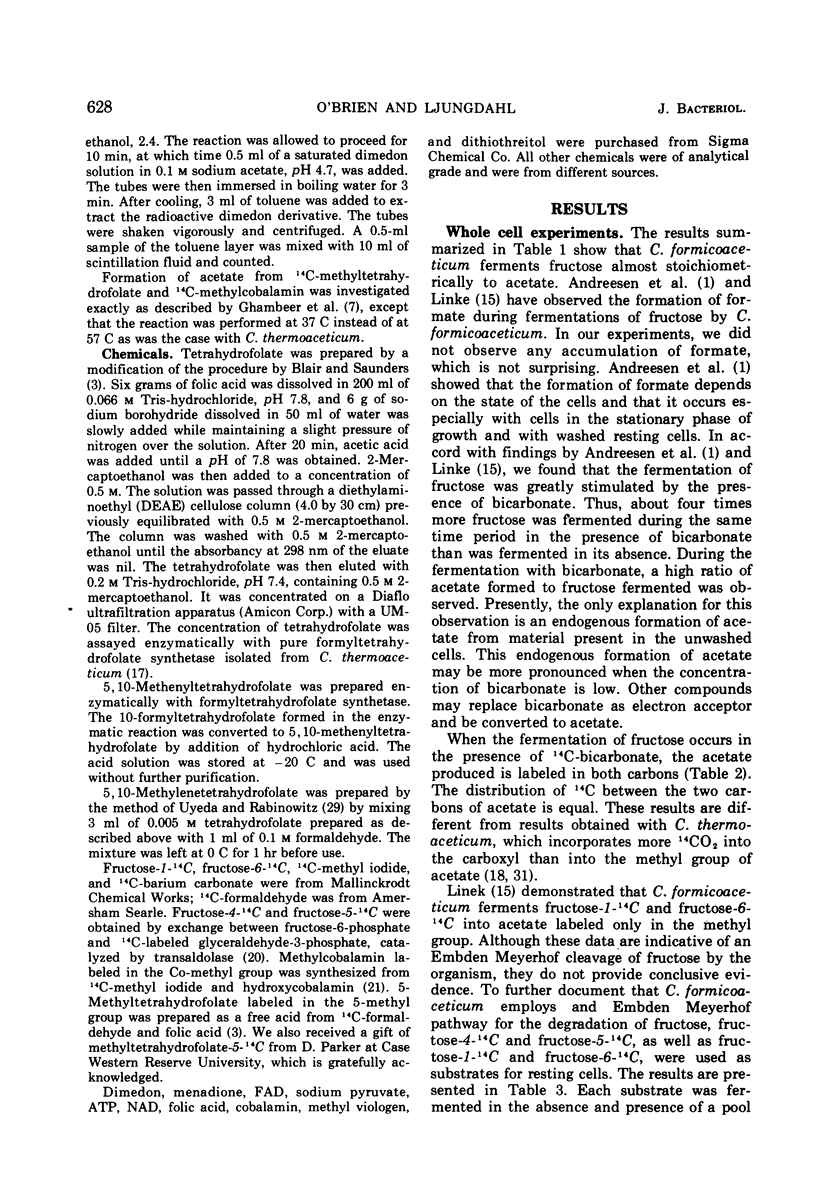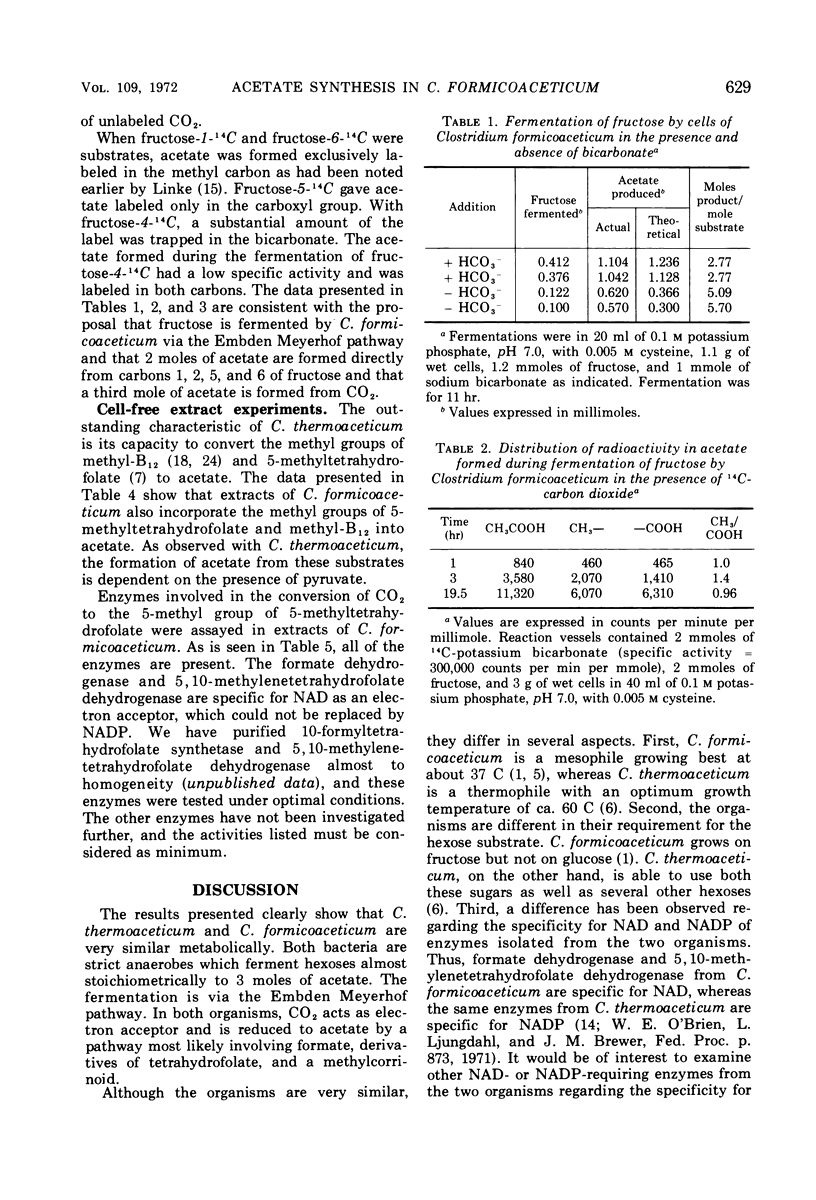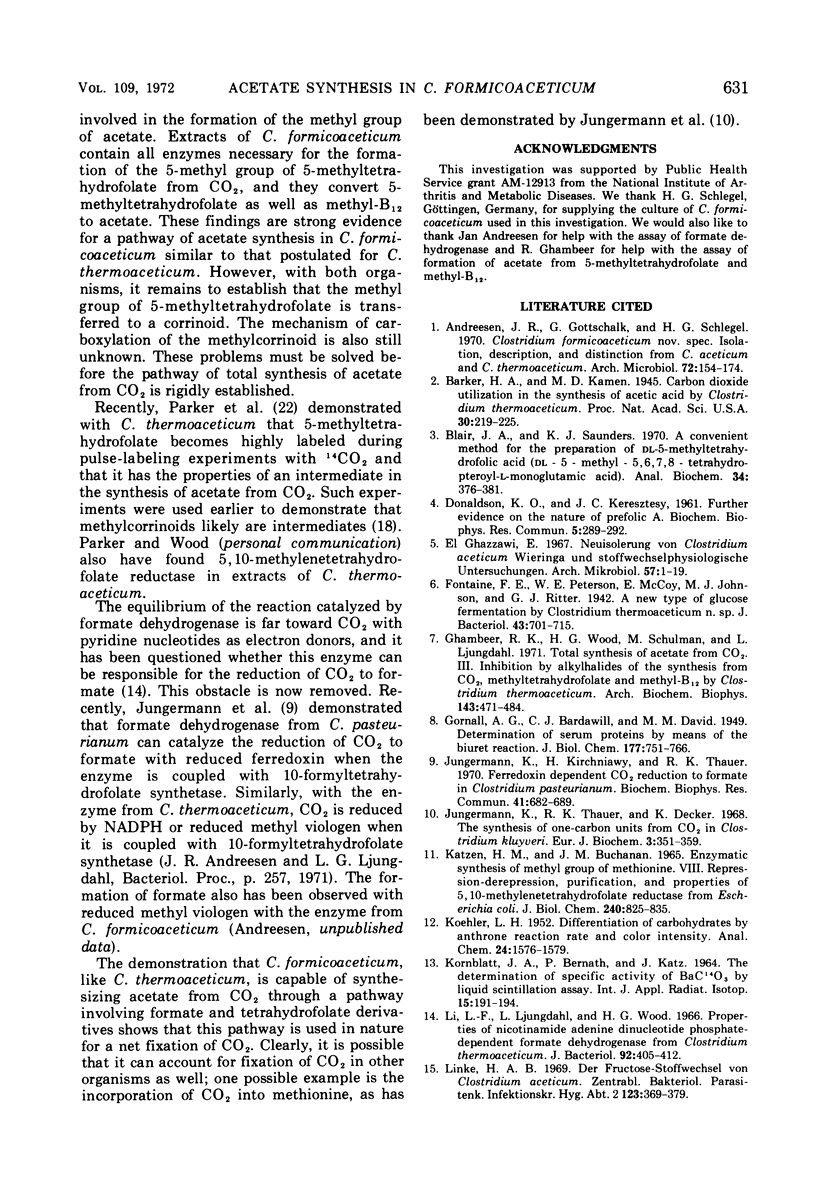Abstract
Clostridium formicoaceticum ferments fructose labeled with 14C in carbon 1, 4, 5, or 6 via the Embden Meyerhof pathway. In fermentations of fructose in the presence of 14CO2, acetate is formed labeled equally in both carbons. Extracts convert the methyl groups of 5-methyltetrahydrofolate and methyl-B12 to the methyl group of acetate in the presence of pyruvate. Formate dehydrogenase, 10-formyltetrahydrofolate synthetase, 5,10-methenyltetrahydrofolate cyclohydrolase, 5,10-methylenetetrahydrofolate dehydrogenase, and 5,10-methylenetetrahydrofolate reductase are present in extracts of C. formicoaceticum. These enzymes are needed for the conversion of CO2 to 5-methyltetrahydrofolate. It is proposed that acetate is totally synthesized from CO2 via the reactions catalyzed by the enzymes listed above and that 5-methyltetra-hydrofolate and a methylcorrinoid are intermediates in this synthesis.
Full text
PDF






Selected References
These references are in PubMed. This may not be the complete list of references from this article.
- Andreesen J. R., Gottschalk G., Schlegel H. G. Clostridium formicoaceticum nov. spec. isolation, description and distinction from C. aceticum and C. thermoaceticum. Arch Mikrobiol. 1970;72(2):154–174. doi: 10.1007/BF00409521. [DOI] [PubMed] [Google Scholar]
- Barker H. A., Kamen M. D. Carbon Dioxide Utilization in the Synthesis of Acetic Acid by Clostridium Thermoaceticum. Proc Natl Acad Sci U S A. 1945 Aug;31(8):219–225. doi: 10.1073/pnas.31.8.219. [DOI] [PMC free article] [PubMed] [Google Scholar]
- Blair J. A., Saunders K. J. A convenient method for the preparation of dl-5-methyltetrahydrofolic acid (dl-5-methyl-5,6,7,8-tetrahydropteroyl-L-monoglutamic acid). Anal Biochem. 1970 Apr;34(2):376–381. doi: 10.1016/0003-2697(70)90122-3. [DOI] [PubMed] [Google Scholar]
- DONALDSON K. O., KERESZTESY J. C. Further evidence on the nature of prefolic A. Biochem Biophys Res Commun. 1961 Jul 26;5:289–292. doi: 10.1016/0006-291x(61)90165-6. [DOI] [PubMed] [Google Scholar]
- El Ghazzawi E. Neuisolierung von Clostridium aceticum Wieringa und stoffwechselphysiologische Untersuchungen. Arch Mikrobiol. 1967 May 17;57(1):1–19. [PubMed] [Google Scholar]
- Fontaine F. E., Peterson W. H., McCoy E., Johnson M. J., Ritter G. J. A New Type of Glucose Fermentation by Clostridium thermoaceticum. J Bacteriol. 1942 Jun;43(6):701–715. doi: 10.1128/jb.43.6.701-715.1942. [DOI] [PMC free article] [PubMed] [Google Scholar]
- Ghambeer R. K., Wood H. G., Schulman M., Ljungdahl L. Total synthesis of acetate from CO2. 3. Inhibition by alkylhalides of the synthesis from CO2, methyltetrahydrofolate, and methyl-B12 by Clostridium thermoaceticum. Arch Biochem Biophys. 1971 Apr;143(2):471–484. doi: 10.1016/0003-9861(71)90232-3. [DOI] [PubMed] [Google Scholar]
- Jungermann K., Kirchniawy H., Thauer R. K. Ferredoxin dependent CO-2 reduction to formate in Clostridium pasteurianum. Biochem Biophys Res Commun. 1970 Nov 9;41(3):682–689. doi: 10.1016/0006-291x(70)90067-7. [DOI] [PubMed] [Google Scholar]
- Jungermann K., Thauer R. K., Decker K. The synthesis of one-carbon units from CO2 in Clostridium kluyveri. Eur J Biochem. 1968 Jan;3(3):351–359. doi: 10.1111/j.1432-1033.1968.tb19536.x. [DOI] [PubMed] [Google Scholar]
- KATZEN H. M., BUCHANAN J. M. ENZYMATIC SYNTHESIS OF THE METHYL GROUP OF METHIONINE. 8. REPRESSION-DEREPRESSION, PURIFICATION, AND PROPERTIES OF 5,10-METHYLENETETRAHYDROFOLATE REDUCTASE FROM ESCHERICHIA COLI. J Biol Chem. 1965 Feb;240:825–835. [PubMed] [Google Scholar]
- KORNBLATT J. A., BERNATH P., KATZ J. THE DETERMINATION OF SPECIFIC ACTIVITY OF BAC14O3 BY LIQUID SCINTILLATION ASSAY. Int J Appl Radiat Isot. 1964 Apr;15:191–194. doi: 10.1016/0020-708x(64)90065-1. [DOI] [PubMed] [Google Scholar]
- LJUNGDAHL L., WOOD H. G., RACKER E., COURI D. Formation of unequally labeled fructose 6-phosphate by an exchange reaction catalyzed by transaldolase. J Biol Chem. 1961 Jun;236:1622–1625. [PubMed] [Google Scholar]
- Li L. F., Ljungdahl L., Wood H. G. Properties of Nicotinamide Adenine Dinucleotide Phosphate-Dependent Formate Dehydrogenase from Clostridium thermoaceticum. J Bacteriol. 1966 Aug;92(2):405–412. doi: 10.1128/jb.92.2.405-412.1966. [DOI] [PMC free article] [PubMed] [Google Scholar]
- Linke H. A. CO2-Fixierung durch Clostridium aceticum: 14CO2-Kurzzeiteinbau und Pyruvatstoffwechesel. Arch Mikrobiol. 1969;64(3):203–214. [PubMed] [Google Scholar]
- Linke H. A. Der Fructose-Stoffwechsel von Clostridium aceticum. Zentralbl Bakteriol Parasitenkd Infektionskr Hyg. 1969;123(4):369–379. [PubMed] [Google Scholar]
- Ljungdahl L. G. Total synthesis of acetate from CO2 by heterotrophic bacteria. Annu Rev Microbiol. 1969;23:515–538. doi: 10.1146/annurev.mi.23.100169.002503. [DOI] [PubMed] [Google Scholar]
- Ljungdahl L., Brewer J. M., Neece S. H., Fairwell T. Purification, stability, and composition of formyltetrahydrofolate synthetase from Clostridium thermoaceticum. J Biol Chem. 1970 Sep 25;245(18):4791–4797. [PubMed] [Google Scholar]
- Ljungdahl L., Irion E., Wood H. G. Total synthesis of acetate from CO2. I. Co-methylcobyric acid and CO-(methyl)-5-methoxybenzimidazolylcobamide as intermediates with Clostridium thermoaceticum. Biochemistry. 1965 Dec;4(12):2771–2780. doi: 10.1021/bi00888a030. [DOI] [PubMed] [Google Scholar]
- PHARES E. F. Degradation of labeled propionic and acetic acids. Arch Biochem Biophys. 1951 Sep;33(2):173–178. doi: 10.1016/0003-9861(51)90094-x. [DOI] [PubMed] [Google Scholar]
- Parker D. J., Wu T. F., Wood H. G. Total synthesis of acetate from CO 2 : methyltetrahydrofolate, an intermediate, and a procedure for separation of the folates. J Bacteriol. 1971 Nov;108(2):770–776. doi: 10.1128/jb.108.2.770-776.1971. [DOI] [PMC free article] [PubMed] [Google Scholar]
- Poston J. M., Kuratomi K., Stadtman E. R. The conversion of carbon dioxide to acetate. I. The use of cobalt-methylcobalamin as a source of methyl groups for the synthesis of acetate by cell-free extracts of Clostridium thermoaceticum. J Biol Chem. 1966 Sep 25;241(18):4209–4216. [PubMed] [Google Scholar]
- RABINOWITZ J. C., PRICER W. E., Jr Formyltetrahydrofolate synthetase. I. Isolation and crystallization of the enzyme. J Biol Chem. 1962 Sep;237:2898–2902. [PubMed] [Google Scholar]
- SWIM H. E., KRAMPITZ L. O. Acetic acid oxidation by Escherichia coli; evidence for the occurrence of a tricarboxylic acid cycle. J Bacteriol. 1954 Apr;67(4):419–425. doi: 10.1128/jb.67.4.419-425.1954. [DOI] [PMC free article] [PubMed] [Google Scholar]
- Schulman M., Parker D., Ljungdahl L. G., Wood H. G. Total synthesis of acetate from CO 2 . V. Determination by mass analysis of the different types of acetate formed from 13 CO 2 by heterotrophic bacteria. J Bacteriol. 1972 Feb;109(2):633–644. doi: 10.1128/jb.109.2.633-644.1972. [DOI] [PMC free article] [PubMed] [Google Scholar]
- Trudinger P. A. On the absorbancy of reduced methyl viologen. Anal Biochem. 1970 Jul;36(1):222–225. doi: 10.1016/0003-2697(70)90351-9. [DOI] [PubMed] [Google Scholar]
- Uyeda K., Rabinowitz J. C. Enzymes of clostridial purine fermentation. Methylenetetrahydrofolate dehydrogenase. J Biol Chem. 1967 Oct 10;242(19):4378–4385. [PubMed] [Google Scholar]
- WOOD H. G. A study of carbon dioxide fixation by mass determination of the types of C13-acetate. J Biol Chem. 1952 Feb;194(2):905–931. [PubMed] [Google Scholar]
- WOOD H. G. Fermentation of 3, 4-C14-and 1-C14-labeled glucose by Clostridium thermoaceticum. J Biol Chem. 1952 Dec;199(2):579–583. [PubMed] [Google Scholar]


